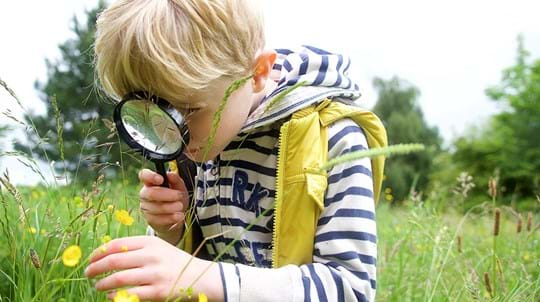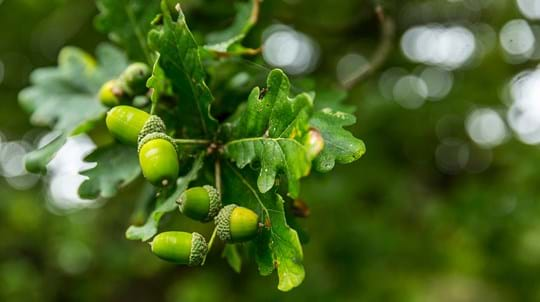
Penn Wood (1)
Penn Street

Woodland Trust wood
176.33 ha (435.71 acres)
SU914959
Explorer 172
OS Landranger 165
Penn Wood lies in the heart of the Chilterns Area of Outstanding Natural Beauty (AONB). It has a long history and was once part of a very large common called Wycombe Heath. A herd of cows is still used to manage part of the site today as wood pasture, and this continues the traditional management carried out in the past.
The wood contains impressive bluebell sections in the spring and red kites and buzzards are commonly seen overhead. Look out for dragonflies near the ponds and butterflies in the patchwork of habitats at Penn.
Features
- Parking nearby
- Public access
- Spring flowers
- Waymarked walk
- Grassland
How to get to Penn Wood
At 176.3 hectares (435 acres), Penn Wood is one of the largest ancient woodlands in the Chilterns Area of Outstanding Natural Beauty (AONB).
It is close to the village of Penn Street near Beaconsfield in Buckinghamshire.
From junction 4 of the M40, turn north on the A404 into High Wycombe and remain on the A404 through the town, following signs for Amersham and Hazlemere. The A404 passes through Hazlemere and climbs a hill. At the top of the hill, go past the first right, signposted for Penn Bottom, and take the next right 2km (1.2 miles) further on, signposted for Penn Street.
The nearest train stations are at Beaconsfield, 4.8km (3 miles) from the wood; Amersham, 6.4km (4 miles) away and High Wycombe, 8km (5 miles).
Visit National Rail for more information.
The nearest bus stop is near Mop End on Penn Street.
Visit Traveline for more information.
Facilities and access
There are seven main entrances to Penn Wood and three rights of way running through the wood which link it to the surrounding countryside. A surfaced, 360-metre circular, easy access path runs from the entrance of Penn Street church, together with a 1km surfaced bridleway. There are also many more permissive paths totalling around 10,000 metres (10km), which provide a variety of walking routes for the visitor. A link to Common Wood (another wood with public access) can also be found at the western corner of Penn Wood.
In general, the paths are moderately easy to walk on but do get muddy during the winter months.
There is a range of places to park in the village, including a large car park at the Holy Trinity C of E Church. Some provision for parking has also been made at the wood entrances. Please leave the Quaker Gate clear for management access.
There are toilets available to customers in the pubs on Penn Street. The nearest public toilets are at Dovecote Meadow and Woodside Close in Amersham, around 7km (4.3 miles) away.
Wildlife and habitats
Animals
The mosaic of habitats at Penn Wood supports a diversity of species adapted to different ecological niches. The butterflies on site are particularly varied and the wood houses plenty of woodland birds, such as the tawny owl, while red kites and buzzards fly overhead.
In the middle ages, wolves and wild boar roamed the wood. The Trust is working on restoring the habitat for some of its more recent residents, such as the skylark, dormouse and woodlark.
Trees, plants and fungi
Penn Wood is ‘old-growth’ woodland, with trees that are over 200 years old. There are at least 50 such trees on the site, most being beech. A section of the wood is conifer-dominated, while the rest is broadleaved woodland and open grassland. We are now working to restore the woodland to its former glory.
Grazing now takes place for most of the year by over a dozen Dexter cows to maintain a wood pasture habitat. These cows are playing an important role in restoring the woods by grazing and trampling some of the young trees and scrub which encourages the species-rich grasslands to return.
Habitats
The varied habitats at Penn Wood play host to a wide range of flora and fauna. Areas of ancient woodland and traditionally managed grassland are particularly rare and valuable.
History of Penn Wood
From a clay-digging site to a Second World War army training camp, Penn Wood has a rich history.
The Enclosure Acts
The Enclosure Acts were a series of Acts of Parliament which changed legal property rights to land that had previously permitted communal use. In 1855, ownership of Penn Wood passed to the 1st Earl Howe and many local people who had relied on the land for grazing livestock were forced off it.
There local anger and for many years there were unlawful protests in the woods, including poaching and vandalism of fences, as local people tried to reclaim the land they had relied on and felt was legitimately theirs to use.
Chair-making at Penn Wood
Chair-making started as a cottage industry in the villages of the Chilterns in the 17th century, but after the Industrial Revolution in the late 18th century, High Wycombe became a centre for chair production. Local woods like Penn Wood were an important source of timber for the industry.
As the industry boomed, large areas of oak trees were felled and replaced with tall, narrow beech trees, which suited handling better.
While much of the work took place in local factories, bodgers (wood turners) went into woods to do their work as it was easier than transporting timber to their workshops. Bodgers would purchase stands of trees and work nearby, and finished pieces would be left to dry out.

Credit: Adam Burton / WTML
Acquisition
Public access to the wood has now been restored, thanks to the efforts of the local community. In 1993, the then owner of Penn Wood submitted plans to build an 18-hole golf course. Many members of the public, led by the Friends of Penn Wood, opposed the scheme and ran a six-year campaign against the proposal.
Thanks to their efforts, the proposal was rejected and the Woodland Trust acquired Penn Wood in 1999. A purple-leaf beech tree was planted by the 7th Earl Howe to celebrate the triumph of saving the important ancient woodland.
Archaeology
The wood is crisscrossed by banks and ditches, some of which may have marked the boundaries of different owners or acted as a means to keep animals away from young trees for woodland management. There is a large woodbank surrounding the perimeter which is a typical feature of ancient woodland; and an earthwork enclosure in the wood which is similar to those found in other Chiltern woods. These enclosures may have been connected to hunting lodges or gamekeepers’ huts.

A lasting legacy
This wood is just one of many to have been protected by gifts in wills, securing it for generations to come. Your legacy gift could also make a real difference to woods, trees and wildlife.
Learn what your gift could meanThings to do in Penn Wood

Visiting woods
Walking dogs in our woods
Dogs are welcome for walkies in our woods. Take a look at our tips and guidelines for ensuring we keep our woods safe and special for dogs and wildlife.

Visiting woods
Events
Discover events at our woods and the festivals and fairs you can find us at soon.

Visiting woods
Things to do in the woods
Go on an adventure. Get closer to nature. Uncover history. Discover ways to explore the UK's woods whatever the season.




































